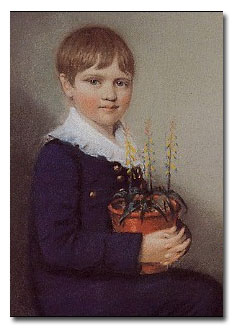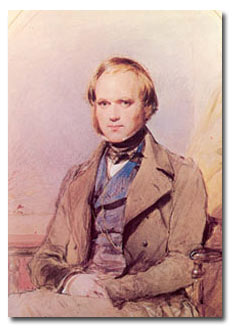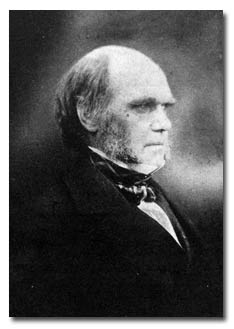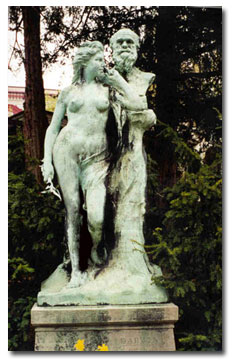|
||||||||||||||||||||||||||||||||||||
2009, the 200th Anniversary of Charles Darwin's Birth |
|
Brief Biographical SketchCharles Robert Darwin was born to Robert Waring Darwin and Susannah (née Wedgwood) Darwin on 12 February 1809 at the family home in Shrewsbury, England. Charles was the fifth of six children, including an elder brother and four sisters; the sisters served as surrogate mothers for their younger brother when Susannah Darwin died in 1817. Robert Darwin was a wealthy doctor and the son of Erasmus Darwin, who himself had advanced evolutionary proposals in his widely read Zoonomia, or the Laws of Life (1796-1798). At age sixteen, Darwin followed in the footsteps of grandfather, father, and elder brother Erasmus and enrolled at Edinburgh medical school, where he came into contact with Robert Grant, an expert on sponges and an advocate of Lamarck’s transmutational hypothesis. Darwin came down from Edinburgh after two years of a “dreadful experience.” Through the aid of Henslow, Darwin had opportunity to sail to the tropics on H.M.S. Beagle. The Beagle, under the command of the twenty-seven-year-old Robert FitzRoy, had the task of charting the waters off the coasts of South America, Australia, and the Pacific Islands. Darwin was to act as ships naturalist and companion to the captain. The ship embarked from Plymouth harbor on 27 December 1831 and would not return until 4 October 1836. During the voyage Darwin and the manic-depressive FitzRoy had a rocky relationship (and after the publication of the Origin of Species, FitzRoy took to railing against the evil book). As the ship lay at anchor in the various ports along the coast of South America, Darwin would travel inland to survey the geology (with the volumes of Lyell’s Principles of Geology as a guide), as well as the animal and plant life. He sent back many specimens to England, including the fossil remains of a giant Megatherium. The ship reached the Galapagos archipelago on 15 September 1835, and remained visiting the various islands for about a month. Darwin noted many of the peculiarities of the fauna, especially the similar varieties of tortoise on the different islands. The only hint that he may have been thinking in terms congenial to his grandfather and Lamarck was his brief observation made on the return voyage that the similarity of fauna in geologically proximate areas, especially on the Galapagos and Falkland islands, might have consequence: “If there is the slightest foundation for these remarks, the Zoology of Archipelagoes will be well worth examining; for such facts would undermine the stability of species.” After his return in October of 1836, while cataloging his collections in early spring of the following year, Darwin came to understand, especially through conversations with John Gould (chief ornithologist of the British Museum), that the three types of mockingbird he brought back from the Galapagos were not simply varieties of one species that had been altered by different environments but that they were good and true species. This ignited a brain ready to explode with fresh ideas about natural history. While on the Beagle, Darwin kept a diary and notes on geology, zoology, birds, insects, and plants. All the while Darwin worked on his species theory, he was quite busily engaged on the publication of the results of his voyage. The diary and zoological notes kept on the Beagle, as well as his geology notebooks supplied material for the first edition (1839) of his Journal of Researches into the Geology and Natural History of the various Countries visited by H.M.S. Beagle. While certain passages in the book hinted at his new hypothesis about species, only in retrospect could they be so recognized. In the second edition (1845), more passage alluded to the new perspective, but again these passed unnoticed by readers. The geology notebooks, as well as specimens sent back from the voyage to London, served as foundation for the five part catalogue of The Zoology of H.M.S. Beagle (1838-1843), with introductions and supervision by Darwin but material described by various experts (e.g., Richard Owen, George Waterhouse, John Gould, etc.). Darwin himself composed the three volumes of the Geology of the Voyage of the Beagle (1842-1846). In late 1846, he became interested in a small, quite unusual barnacle that lived within the shell of a mollusk. Intrigued with this new species, he began an exploration that would occupy him for the next eight years and would yield two folio volumes on Living Cirripedia and two on Fossil Cirripedia (1851-1854). This exhaustive study again hinted at his theory by implicitly endorsing the principle that ontogeny recapitulated phylogeny, a principle that appeared on the very initial page of his first transmutation notebook (Notebook B, MS p. 1). |
After completing his work on barnacles, Darwin finally resolved to produce a big book on species that would spell out his theory and the myriad of evidence that supported it. His pocket diary records on 14 May 1856: “Began by Lyell’s advice writing species sketch.” By the following fall, the sketch grew far beyond his initial intention. His expanding composition was to be called Natural Selection, and it would likely have gone to two fat volumes, crammed with evidence derived from his voluminous reading, his experiments on plants and in embryology, and his mathematical analyses of species patterns. However, the composition of the book was interrupted on 28 June 1858 by a letter from a sometime correspondent, Alfred Russel Wallace, then collecting species in Borneo. Darwin’s Origin had a phenomenal success. In 1859, when it was published, one could hardly find a professional naturalist in Europe or America who believed in the transmutation of species. By 1882, when Darwin died, one could hardly find a professional naturalist who did not accept the evolution of species, even if many yet contended about the causes of species change. Critics and colleagues alike succumbed to the character of the man, both as represented in his book and in his person. Ernst Haeckel, Darwin’s great champion in Germany—and the man most responsible for the warfare between evolutionary science and religion—visited Darwin at Down House in 1867 while on his way to the Canary Islands. He left this character impression of that first meeting:
While producing the several editions of his book, Darwin continued to work on an amazing number of other projects. In 1862 and 1865, he published on orchids and climbing plants; and in 1868 his two volume Animals and Plants under Domestication appeared. In that latter work, he proposed a kind of genetic theory (his hypothesis of “pangenesis”) that would accommodate the inheritance of acquired characters; and he commissioned his cousin, Francis Galton, to do some experiments to establish its validity. During the late 1860s, Darwin began a series of exchanges on sexual selection with his new friend Wallace. As a result he began to work on a book that would argue his particular version of sexual selection, which he thought a key to understanding the origin of the human races and sexual dimorphism in men and animals. At the end of the decade, another dispute with Wallace broke out, a much more serious one this time. Wallace had converted to spiritualism and became convinced that higher spiritual powers were responsible for man’s enlarged intellect and moral character. During the last decade of his life, Darwin continued research on plants, publishing three more books, as well as a final dénouement on the lowly earth worm. He died on 19 April 1882 without benefit of clergy, and, nonetheless, was buried with great ceremony in Westminster Abbey on 25 April that year. RJR Select Bibliography Browne, Janet, Charles Darwin Voyaging (Princeton, 1995). Browne, Janet, Charles Darwin: the Power of Place (Princeton, 2003). Darwin, Charles, The Autobiography of Charles Darwin, ed. Nora Barlow (Norton, 1993). Darwin, Charles, Voyage of the Beagle (2nd ed.), ed. Steve Jones (Modern Library, 2001). Desmond, Adrian and James Moore, Darwin: the Life of a Tormented Evolutionist (Norton, 1994). |
|
Conference | Registration | Chicago | Contacts © 2008 University of Chicago |



 Feeling the disappointment of his father, he then (1828) enrolled at Christ College, Cambridge University, with the idea of becoming a country parson, a respectable occupation for the youngest son of the English gentry, even if the son felt no keen desire to pursue holy orders. Though spending a fair amount of his time collecting beetles and enjoying dinner parties, he came to know the botanist John Henslow, who introduced him to certain questions coming out of Germany about the origins of life and embryological development. In order to pass out among those not seeking an honors degree, Darwin had to “get up” Paley’s Evidences of Christianity and his Natural Theology. But the book that inspired him as no other was Alexander von Humboldt’s Personal Narrative of Travels to the Equinoctial Regions of the New Continent, 1799-1804; it kindled a desire for exotic travel and research.
Feeling the disappointment of his father, he then (1828) enrolled at Christ College, Cambridge University, with the idea of becoming a country parson, a respectable occupation for the youngest son of the English gentry, even if the son felt no keen desire to pursue holy orders. Though spending a fair amount of his time collecting beetles and enjoying dinner parties, he came to know the botanist John Henslow, who introduced him to certain questions coming out of Germany about the origins of life and embryological development. In order to pass out among those not seeking an honors degree, Darwin had to “get up” Paley’s Evidences of Christianity and his Natural Theology. But the book that inspired him as no other was Alexander von Humboldt’s Personal Narrative of Travels to the Equinoctial Regions of the New Continent, 1799-1804; it kindled a desire for exotic travel and research.  The evidence from these sources indicates that he remained orthodox in biology for most of the journey, and only on the return did he jot in his ornithological notes the passage cited above. In late May of 1836, while on the return, he opened his Red Notebook (so-called because of its cover), which contains entries mostly on geology; and he continued to post entries until spring of 1837. This notebook contains the first brief speculations on species change in entries of March 1837 (MS pp. 127-30, and 153). In July he began a geology notebook and a series of notebooks on the transmutation of species (his B, C, D, E, M, and N Notebooks), as well as many loose notes on questions of species change. These notebooks would furnish ideas for the first extended essay-draft that began to lay out his theory of species change by natural selection. He jotted out a pencil sketch (35 MS pages) in 1842, and greatly expanded the essay (230 MS pages) two years later, for which he had a fair copy made lest he die before his theory could be published. These essays contain the skeleton of the Origin of Species.
The evidence from these sources indicates that he remained orthodox in biology for most of the journey, and only on the return did he jot in his ornithological notes the passage cited above. In late May of 1836, while on the return, he opened his Red Notebook (so-called because of its cover), which contains entries mostly on geology; and he continued to post entries until spring of 1837. This notebook contains the first brief speculations on species change in entries of March 1837 (MS pp. 127-30, and 153). In July he began a geology notebook and a series of notebooks on the transmutation of species (his B, C, D, E, M, and N Notebooks), as well as many loose notes on questions of species change. These notebooks would furnish ideas for the first extended essay-draft that began to lay out his theory of species change by natural selection. He jotted out a pencil sketch (35 MS pages) in 1842, and greatly expanded the essay (230 MS pages) two years later, for which he had a fair copy made lest he die before his theory could be published. These essays contain the skeleton of the Origin of Species. Wallace included in his letter an essay entitled “On the Tendency of Varieties to Depart Indefinitely from the Original Type.” Darwin was crushed. It seemed as if this obscure naturalist had been cribbing ideas from Darwin’s own notebooks, so similar were their conceptions. After being convinced that honor did not require him to retire and give place to Wallace, Lyell and Hooker arranged to have portions of Darwin’s notebooks and Wallace’s essay read before the Linnaean Society on 1 July 1858. The event and the publication of their papers in the Society’s journal raised hardly an eyebrow (Asa Gray in America was an exception). Darwin then set out to condense what he had already written for his big species book (some seven chapters) and quickly add the remaining chapters that he had planned. His self-styled “abstract,” On the Origin of Species (see the analysis on this website), was published on 26 November 1859, in a run of 1250 copies. It would eventually go through six editions, with Darwin adding material and answering his critics, so that by the last edition of 1872 (and several subsequent printings) the book had been altered by about fifty percent.
Wallace included in his letter an essay entitled “On the Tendency of Varieties to Depart Indefinitely from the Original Type.” Darwin was crushed. It seemed as if this obscure naturalist had been cribbing ideas from Darwin’s own notebooks, so similar were their conceptions. After being convinced that honor did not require him to retire and give place to Wallace, Lyell and Hooker arranged to have portions of Darwin’s notebooks and Wallace’s essay read before the Linnaean Society on 1 July 1858. The event and the publication of their papers in the Society’s journal raised hardly an eyebrow (Asa Gray in America was an exception). Darwin then set out to condense what he had already written for his big species book (some seven chapters) and quickly add the remaining chapters that he had planned. His self-styled “abstract,” On the Origin of Species (see the analysis on this website), was published on 26 November 1859, in a run of 1250 copies. It would eventually go through six editions, with Darwin adding material and answering his critics, so that by the last edition of 1872 (and several subsequent printings) the book had been altered by about fifty percent.  In the Descent of Man and Selection in relation to Sex (1871), Darwin sought to give an extended analysis of sexual selection (in the second volume) and a detailed account of man’s distinctive traits, especially his moral nature (in the first volume). He thus responded to Wallace and others who doubted the capacious efficacy of natural selection. His theory of the evolution of morality would give rise to a very large response, positive and negative, from his time to ours.
In the Descent of Man and Selection in relation to Sex (1871), Darwin sought to give an extended analysis of sexual selection (in the second volume) and a detailed account of man’s distinctive traits, especially his moral nature (in the first volume). He thus responded to Wallace and others who doubted the capacious efficacy of natural selection. His theory of the evolution of morality would give rise to a very large response, positive and negative, from his time to ours.